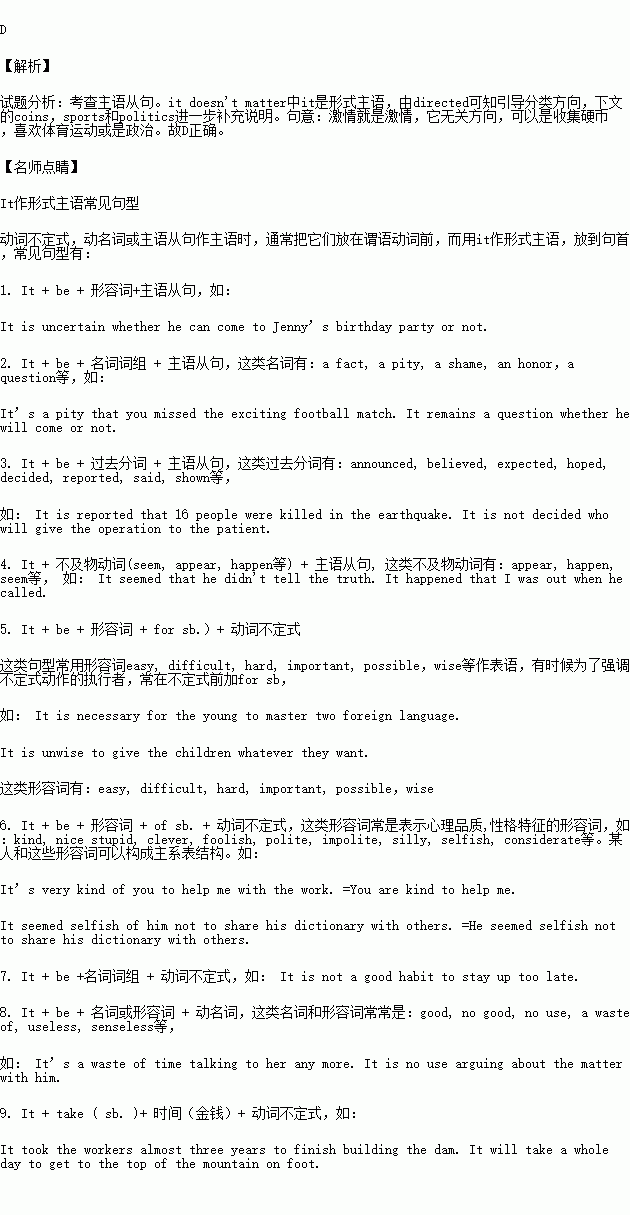题目内容
Passion is passion and it doesn't matter____ it's directed. Exactly, it can be coins or sports or politics.
A. why B. how C. whether D. where
任务型阅读
请认真阅读下列短文,并根据所读内容在文章后表格中的空格里填入一个最恰当的单词。注意:请将答案写在答题纸上相应题号的横线上。每个空格只填一个单词。
Family structure is the core of any culture. A major function of the family is to socialize new members ofa culture. As children are raised in a family setting, they learn to become members of the family as well as members of the larger culture. The family provides the model for all other relationships in society. Through the observations and modeling of the behavior of other family members, children learn about the family and society including the values of the culture. Family structure and their inherent relationships and obligations are a major source of cultural difference.
The family is the center of most traditional Asians' lives. Many people worry about their families' welfare, reputation, and honor. Asian families are often extended, including several generations related by blood or marriage living in the same home. An Asian person's misdeeds are not blamed just on the individual but also on the family—including the dead ancestors.
Traditional Chinese, among many other Asians, respect their elders and feel a deep sense of duty toward them. Children repay their parents' sacrifices by being successful and supporting them in old age. This is accepted as a natural part of life in China. In contrast, taking care of aged parents is often viewed as tremendous burden in the United States, where aging and family support are not honored highly.
The Vietnamese family consists of people currently alive as well as the spirits of the dead and of the as-yet unborn. Any decisions or actions are done from family considerations, not individual desires. People's behavior is judged on whether it brings shame or pride to the family. Vietnamese children are trained to rely on their families, to honor elderly people, and to fear foreigners. Many Vietnamese think that their actions in this life will influence their status in the next life.
Fathers in traditional Japanese families are typically strict and distant. Japanese college students in one study said they would tell their fathers just about as much as they would tell a total stranger. The emotional and communication barrier between children and fathers in Japan appears very strong after children have reached a certain age.
Although there has been much talk about "family values" in the United States, the family is not a usual frame of reference for decisions in U.S. mainstream culture. Family connections are not so important to most people. Dropping the names of wealthy or famous people the family knows is done in the United States, but it is not viewed positively. More important is a person's own individual "track record" of personal achievement.
Thus, many cultural differences exist in family structures and values. In some cultures, the family is the center of life and the main frame of reference for decisions. In other cultures, the individuals, not the family, is primary. In some cultures, the family's reputation and honor depend on each person's actions; in other cultures, individuals can act without permanently affecting the family life. Some cultures value old people, while other cultures look down on them.
(Adapted from R. L. Oxford & R. C. Scarcella, "A Few Family Structures and Values Around the Globe")
Outline | Supporting details |
1. A to family structure | Family structure is of great 2. A in different cultures. Children raised in a family will gradually learn how to 3. A in a way which is acceptable in their culture or setting. 'Many cultural differences 4. A from family structures. |
Examples of Asian families | Traditional Asians 5. A their lives around family. Not only the individual but the family is to6. A for any wrongdoings. O In China, parents' sacrifices will probably7. off when children grow up. Children will also provide for the elders. O In Vietnam, it's not from the personal desires but from family considerations that decisions or actions are done. In Japan, children are 8. A to share their emotions with father, thus making communication difficult. |
Examples of families in the USA | Americans don't lay much emphasis on family values. 9. A personal achievement is considered more important. |
Conclusion | Family structures and values 10. A in different cultures. |

